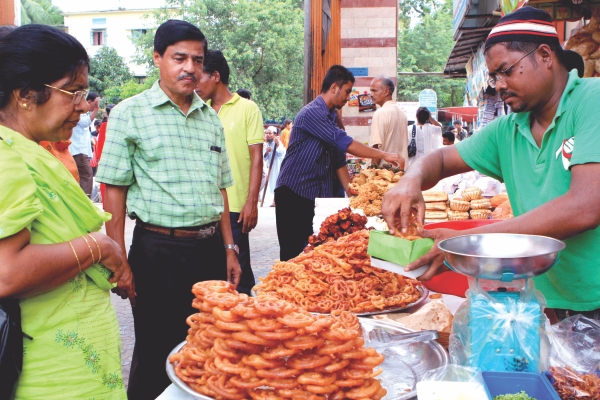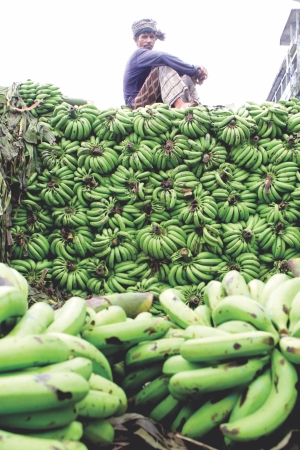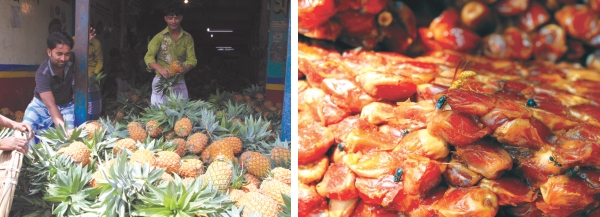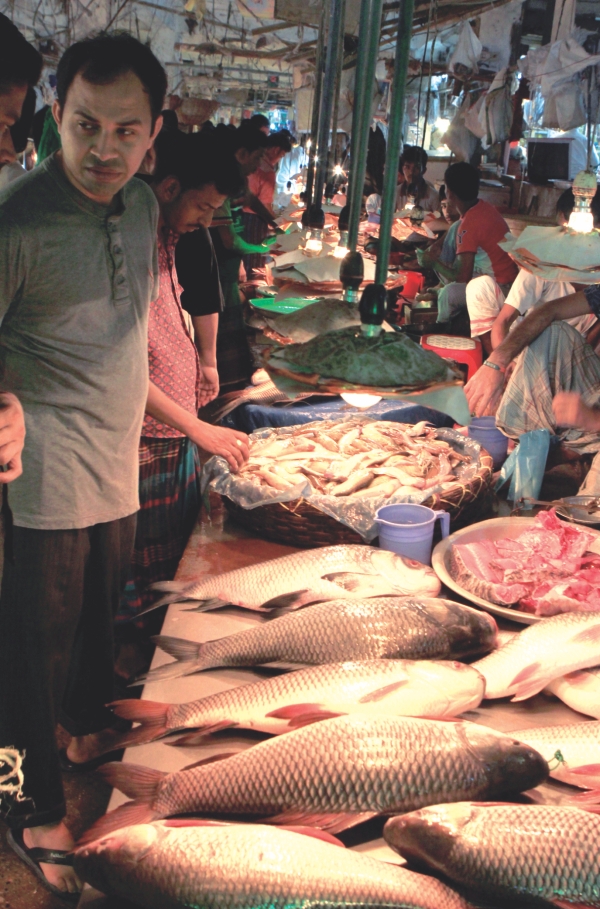| Home - Back Issues - The Team - Contact Us |
 |
| Volume 10 |Issue 32 | August 19, 2011 | |
|
|
Cover Story
Camouflaging Adulterants The month of Ramadan is full of contradictions. It not only sees the Muslims in Bangladesh fast and pray more devoutly than any other month but also observes the steepest rise in the production and sales of adulterated food of all sorts which is considered a serious crime under the Pure Food Ordinance (1959). Existence of numerous government bodies under several ministries without any co-ordination has given the concerned officials the perfect opportunity to pass the buck. However, experts stress the need for forming a strong body that would coordinate as well as lead all other existing bodies to put an end to food adulteration before it goes out of control. Rifat Munim Photos: Zahedul I Khan
Chawkbazar, Dhaka. Five in the afternoon. Weaving his way through the thickly spotted, make-shift iftar shops flooded by fasting customers, Raihan moves ahead, holding his father's hand. They are heading towards Mannan Mia's shop, which is small yet overflowing with a bustle hitherto unknown to Raihan. His father, Kashem Siddique, is here to buy shahi kebab, jilapi, beguni and peyaju –items that are traditionally held as must-have foods for breaking the fast. As Siddique waits his turn, the little boy shifts his attention to the man rolling out the dough, then to the one pouring brownish thick dollops briskly into a giant frying pan. 'Peyaju', his father points out. The heady smell tickles even the most jaded appetite; leave alone the taste buds of a ten-year old. His eyes glisten as the smell sweeps the air. Once the items are bought, they rush back home. “I'm really short of time because on my way home, I'll have to pick up some fruits; nothing much, just some dates and bananas, may be some mangoes as well,” says Siddique. Raihan is not allowed to fast yet, but his most coveted time in the day during Ramadan is dusk when he gets the chance to gorge on the crispy peyaju and mouth-watering kebabs. He likes dates and mangoes too. Only he doesn't know a thing about the danger lurking beneath the camouflaging colours: bright brown potato chops or beguni, or gleaming red jilapi for that matter. The shiny surface of iftar items belie the deadly fact: textile colours are heavily mixed in all those items to give them a fresh look. What is worse, sometimes Mobil (used in vehicles and machinery) is added to make them crispier. “During a recent mobile court, we found several shops in different areas in Dhaka using Mobil in jilapi to make them crispier,” reveals Khalil Ahmed, a DCC (Dhaka City Corporation) magistrate. Besides, edible food colours are expensive while textile colours are available at very cheap rates, he adds. Textile colour is also used in many other items such as candy, chocolate, cake, chewing gum, ice cream, biscuit, chanachur, crisps and various colourful sweetmeats especially kalojam, chamcham etc.–favourites among children. Besides, these foods including the iftar items are produced in very unhygienic conditions. As a result, children are fast becoming the biggest victims of adulteration with textile colours.
Dr Golam Mowla, former director of Institute of Food and Nutrition (IFN) at the University of Dhaka (DU) and also former director general of Bangladesh Standard and Testing Institution (BSTI), says, “Besides industrial dyes, many other chemicals are mixed in these so-called snacks in the name of preservatives which are very harmful for our health, especially for children. Those colours and chemicals not only cause immediate short-term effects such as diarrhoea, dysentery and nausea, but also seriously affect the nerves.”
ABM Faroque, professor of Pharmacy at DU who has hands-on experience of conducting tests to detect adulterants in foods, says, “Children are eating fruits and vegetables that are stripped of vitamins. Lack of proper nutrients is enough to impede their growth. But when textile colours are included in their regular food intake, it may take a heavy toll on them by exposing them to gastric ulcer. It directly attacks their liver. Last but not least, it causes their bone marrow to malfunction which may result in various forms of blood disorders in future.” Quazi Faruque, president of Consumers Association of Bangladesh (CAB), says that we are helpless consumers having no choice other than consuming foods contaminated with adulterants. “Let us begin with rice which is our staple food. Pesticides are sprayed indiscriminately in the paddy fields that are very harmful. Even after paddy is husked, chemical fertiliser urea is used to make rice whiter. Insecticides are used in a similar fashion in the production of vegetables which are also detrimental to health. Likewise, most other food items especially fish and fruits are adulterated as many recent studies have shown,” he says. In this regard, ABM Farouque adds that hydrose is mixed in puffed rice and sugar to make them whiter and look fresh.
It has been years since a number of studies conducted, among others, by the Institute of Public Health (IPH), Dhaka City Corporation and BSTI confirmed the alarming extent to which foods of all kinds were adulterated. Numerous tests done by the Institute of Food and Nutrition (IFN) and the Department of Pharmacy at the University of Dhaka have also come up with identical findings. Notwithstanding such authentic proof of food adulteration, the government has only set up mobile courts, especially during Ramadan, conducted by several government wings including BSTI, DCC and Directorate of Consumers Rights Protection (DCRP) in association with metropolitan magistrates and law enforcing agencies. However, the sporadic nature of such uncoordinated as well as unplanned drives have done little to clip the wings of the adulterators. On the other hand, in the absence of a well-planned, continuous government monitoring cell, the ill-practice has kept up lifting the scale several notches up every year.
In a recent roundtable on food adulteration, jointly organised by The Daily Star and the non-government development organisation RDRS, government officials and eminent researchers have unanimously agreed that no less than 70% food items are adulterated among the approximately 150 items available in the country at present. While speaking on the consequences of consuming adulterated foods, Dr Md Golam Kibria Khan, associate professor of Dhaka Medical College Hospital, said at the roundtable, “The pattern of diseases is changing. In our student life, prevalence of infectious diseases was high. Now the number of patients suffering from cancer, diabetes, and kidney diseases is on the rise due to food adulteration.” Formalin, a mixture of formaldehyde and methanol, is a disinfectant and considered one of the most harmful adulterants. It is mainly needed in the plastic industry, but is also used to preserve dead bodies. However, in our kitchen markets most of the fish are dipped in the diluted solution of formalin. To make matters worse, sometimes the concentrated form of formalin is injected in the head of fish to make sure that it will not rot. “We're told that formalin was used only in imported fish, but small fish especially kachki are dipped in formalin solution too. So now it is proven that local fish can also be contaminated with formalin. This is bad news for us. In fact, fish bones contain all the trace elements including magnesium, calcium, copper, fluoride etc. which are essential for our body. However, many of us cannot deal with bones of big fish and remove the bones from rui, telapiya and koi etc. As a result, they are deprived of the trace elements. So many people eat small fish which are rich in these nutrients and do not require bones to be picked from them.” Thankfully, our national fish Hilsha is not contaminated with formalin, ensures ABM Faroque. However, he informs that formalin is also used in milk, apples, grapes and dates.
“The fruits are dipped in diluted formalin which is why grapes may dry and become shrivelled, but will never rot. In case of milk, there is an enormous gap between the original local producers and the centrally operating milk-producing companies. As a result, middlemen emerge collecting milk from local farmers and handing it over to the companies. But as the whole process of transporting the milk from the village to the capital takes almost the whole day given the ever-deteriorating traffic condition, the middlemen mix concentrated formalin in the milk to keep it from going sour.” Calcium carbide is another adulterant which is sprayed over certain fruits to ripen them artificially as well as quickly. It is used mainly in pineapples, mangoes, papayas, bananas, and also in lychees and jackfruits in a lesser degree. Even spices are not free from adulterants. Most of the red chilli powder found in the market is mixed with brick dust. Fine sawdust is often mixed with cumin and other ground spices, say CAB members. Honey is also frequently adulterated, as lab tests have found sugar syrup often mixed in honey to enhance its sweetness. Nowadays, pure butter oil and ghee are also very rare in the market. Dishonest traders use a host of ingredients such as animal fat, palm oil, potato mash, and vegetable oil to produce fake butter oil. They even mix soap ingredients like steirian oil with ghee, to increase the quantity. Dalda, a vegetable based fat used for cooking is an example of one of the worst cases of adulteration. "Our stomach's temperature is 37 degree Celsius and the melting point of dalda is 54 degree Celsius. Thus there is no way that dalda can be absorbed by the body,' says Golam Mowla. Another adulterated food is condensed milk produced by Bangladeshi manufacturers, which contain little or no milk and is in fact condensed vegetable fat, says a source at BSTI. “The residual effects of formalin and all these artificial colours and adulterants work like poisons in the human body. Apart from cancer, kidney and liver diseases—which are the common consequences—they seriously affect our nerves and increase the risk of falling prey to paralysis. They also gradually damage our body cells making the immune system weaker. Thus, food adulteration can cause a number of degenerative diseases in the long term.” CAB members believe that lack of proper government initiatives is responsible for this. “If the government wills, these problems can be solved in a very short time. The monitoring system should be strengthened. Besides, the Pure Food Ordinance (1959) should be updated. According to the ordinance, depending on the nature of the crime, the adulterator can be imposed a fine or sentenced to jail for not more than three years. Harsher punishments should be ensured by updating the law and enforcing it thereby,” says Quazi Faruque. He also holds the inactive forces of IPH, DCC and DCRP responsible for this. “If these bodies kept monitoring throughout the year, food adulteration would not reach such a level.” BSTI, an autonomous body operating under the Ministry of Industries, is the only National Standards body of Bangladesh that controls standardisation of manufactured products. Monitoring the quality of certain products is also within its ambit. BSTI Director Syed Humayun Kabir says that BSTI is mandated to monitor only 60 packaged items while about 80 other items remain outside its purview. So, he adds, other government bodies under the commerce, food and health ministries should work together to check adulteration.
“Besides, BSTI has only 48 inspectors for a country of over 140 million. We have only 13 inspectors to prevent food contamination in Dhaka which is home to an estimated 13 million people. So we need more people to strengthen our monitoring activities,” he says. Asked about why the drives are conducted only during Ramadan, he says the body cannot conduct drives on its own for not having the power of magistracy. DCC magistrate Khalil Ahmed also speaks of manpower shortage. “DCC's Public Health Laboratory lacks modern equipment which is why we cannot always test certain items or products.” ABM Faroque says that bureaucratic red tape is a major obstacle to stopping adulteration. “Bureaucratic red tape is a major obstacle to infrastructural development in any sector. If BSTI needs to buy a needle worth 10 taka, it may have to send in an application to the finance ministry. Be that as it may, if the concerned officials are enthusiastic enough, then I believe these problems can be overcome. Take, for example, the case of Magistrate Rokon-Ud-Doula. Whenever he felt red tape is deferring legal activities, he sent the samples to the Department of Pharmacy Department at DU because our test results were well accepted by the courts.” Yet, he believes that accountability in the government organisations can go a long way. “Formalin is imported in our country through the office of Chief Controller of Export and Import (CCEI). The CCEI office is supposed to keep records of how much is sold to different companies. Then the companies, plastic companies in most of the cases, sell it illegally to drug stores. So if the CCEI continuously monitors how the bought amount of formalin is used, I think any illegal trading of formalin can be stopped,” Faroque says. He strongly recommends the formation of a Food and Drug Administration that would co-ordinate between all the concerned bodies as well as leading the task of testing and monitoring in an organised way. He says, “The Directorate of Drug Administration has been turned recently into Directorate General of Drug Administration where 300 posts have been created. However, not a single person has been recruited yet as far as we know. We suggest the health ministry transform it into a Directorate General of Food and Drug Administration and recruit competent officials in the vacant posts. Then this administration can work as the leader of all concerned bodies and gradually spread its wings in district levels.” However, Capt (retd) Mujibur Rahman Fakir, state minister for health and family welfare, says, “The Directorate General of Drug Administration cannot be transformed as such because it has been formed to look after drug-related activities only. But I agree that there should be a separate committee in the parliament to address the issue of food adulteration. The existing committee should also be strengthened.” By the existing committee, he refers to the National Food Safety Advisory Council (NFSAC) established in 2005 under Bangladesh Pure Food Ordinance. This council operates under the Ministry of Local Government, Rural Development and Co-operatives. As it appears, there is no dearth of ministries and government bodies to stop food adulteration. In the midst of so many bodies, all the concerned parties have a chance to evade responsibilities by passing the buck. Against this backdrop, what we immediately need is the formation of a central committee or organisation to co-ordinate between as well as lead all the concerned parties. In addition, BSTI and DCC should be equipped with adequate manpower and modern instruments to make sure that they conduct anti-adulteration drives not just during Ramadan but throughout the year. Is there an alternative?
Shahana Bilkis, a resident of Lalmatia, avoids going to the nearby Townhall market as much as possible; she rather enjoys taking the trouble of going all the way to Aati Bazar, Keraniganj to buy her daily necessaries. The ride, which does not take her more than 15 minutes or so, at times involves narrow streets with bumps taking a rambling course through a small township. Yet, the fresh vegetables picked directly from the fields and all the unadulterated dry items including lentils, pulses, chickpeas, red rice and various spices such as red chilli powder and turmeric produced mostly by local farmers bring a flash of smile on her face. “I know it's a bit troublesome for anyone from Dhaka to come to this place, but when you find out the vegetables were picked from the fields just hours ago, you'll feel all your little troubles are worth it,” she says. Despite all her awareness, is it possible to rid herself of the vicious cycle of food adulteration? “At some point, one is compelled to buy adulterated items. But if one is conscious, then the extent can be cut down to a minimal level,” says Shahana who is also assistant professor of a reputed college in the city. She suggests eating fish that remain alive at the time of selling, such as koi, shing and magur; fruits such as guava, lemon, and hog-plum (amra); and shunning fast food as well as anything bought from outside. ABM Faroque echoes Shahana saying that mass awareness can go a long way to cut down the consumption of adulterated food. He prescribes some ways to detect foods that are coated or injected with formalin: a) the sticky surface or clime of the fish’s body becomes dry, no matter how fresh it looks. “Even after detecting formalin in fish or fruit, one can eat it after removing the skin. In case of fish, the head should also be avoided. However, such foods should not be repeatedly eaten,” says ABM Faroque. CAB president Quazi Faruque says that consumers' attitude towards food must be changed. “We are so fascinated with bright colours that we forget the original colours of vegetables, rice, puffed rice, sugar and so on. Original colour of rice, puffed rice and sugar has a slight tinge of brown but we don't buy them unless they are very white. Food sellers manipulate our preoccupation with shiny surface and mix adulterants to make their products glossy.”
Copyright (R) thedailystar.net 2011 |
||||||||








